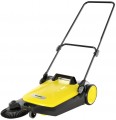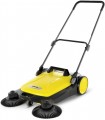Performance
The performance of a cleaning machine is the area that the unit can process in an hour.
Usually, the specs indicate the maximum performance achieved under perfect conditions. It may turn out to be somewhat lower due to the specs of the room, the presence of old dirt and other factors. However, the theoretical difference is usually quite consistent with the actual one. For example, models for 1000 m2/h and 2000 m2/h will differ in performance approximately by two times. So, according to this parameter, it is quite possible to evaluate different models and compare them with each other.
Note that high performance requires a powerful motor and capacious tanks, which affects the dimensions, weight and cost of the unit. Therefore, excessive performance is just as undesirable as insufficient. In addition, more powerful machines usually have a larger working width and are not well suited for rooms with an abundance of narrow passages and nooks and crannies.
As for the actual values, models
less than 1000 m2/h belong to the entry-level. It is the specs that most household machines have (see "Type"). A value
from 1000 to 2000 m2/h is relatively low for professional sweepers and the average for scrubber dryers.
2000 – 3000 m2/h is considered a fairly solid performance, and models of
more than 3000 m2/h is extremely ra
...re. These are mostly high-end sweepers (it is extremely difficult to achieve such characteristics in scrubbers).Side brushes
The number of side brushes provided in the design of the sweeper.
Brushes located on the sides of the body are used in sweepers and vacuum sweepers (see "Type"). They complement the main brush of the unit (usually installed in front of the body or under it) and have two main tasks. The first task is to ensure effective cleaning of hard-to-reach places, such as the space near walls or curbs, floor areas under radiators or shelves, etc. The design of the brush is such that it easily sweeps dust out of narrow spaces. The second task is to increase the working width (see below) and the corresponding increase in productivity (see above).
Modern sweepers can be equipped with
1 or 2 side brushes. In the second case, such devices are installed on both sides of the unit. And the standard location of a single brush is on the right. The brushes can be made detachable — this can be useful for working in narrow spaces, where manoeuvrability and compactness are more important than coverage.
Working width
The width of the space that a harvester can cover in one pass. In models with removable side brushes (see above), this paragraph indicates figures only for the unit itself, and the width of the grip with brushes is specified separately (see below).
The large working width is convenient when working in large open spaces - it allows you to complete the job in fewer passes. In turn, machines with a small working width - and, accordingly, a relatively narrow body - are more passable, they are better suited for environments with a large number of hard-to-reach places. So you should choose based on this parameter taking into account the characteristics of the premises/territories being served.
Working width (with brush)
The width of the area the cleaning machine can cover with one side brush. See above for more details on such brushes. We note that they are used in sweepers (see "Type") to increase the working width and increase overall efficiency, and a single side brush is usually installed on the right side of the body.
In general, a larger working width improves efficiency in large open areas but reduces manoeuvrability in hard-to-reach areas. At the same time, it is worth noting that additional brushes have almost no effect on the width of the body; so it is better to evaluate the machine's performance by its working width, without a brush — see "Working width". However, in some models, only the width of the brush is given — this usually means that the brush is made non-removable; in such cases, you can focus on the overall dimensions of the unit.
Working width (with 2 brushes)
Ширина пространства, которое уборочная машина способна обработать с использованием двух боковых щеток. Подробнее о таких щетках см. выше; здесь же отметим, что они используются в подметальных машинах (см. «Тип») для увеличения ширины захвата и для эффективной обработки труднодоступных мест (например, пространства под бордюрами и стенками). Наличие же двух щеток позволяет эффективно обрабатывать такие места независимо от того, каким боком к ним повернута машина.
Что касается ширины захвата, то в целом бОльшая ширина улучшает эффективность на обширных открытых пространсттвах, однако ухудшает проходимость в труднодоступных местах. В то же время стоит отметить, что дополнительные щетки почти не влияют на ширину корпуса; так что оценивать проходимость машины лучше по ее собственной рабочей ширине, без щеток — см. «Ширина захвата». Впрочем, в некоторых моделях приводится только ширина захвата со щетками — это обычно значит, что щетки сделаны несъемными; в таких случаях можно ориентироваться на общие габариты агрегата.
Weight
The total weight of the cleaning machine. Usually, weight is indicated with empty tanks for detergent, waste, fuel, etc. At the same time, additional equipment, such as side brushes, may or may not be taken into account. Such equipment has a very small weight compared to the machines themselves. And, when installed/removed, does not seriously affect the mass of the entire machine.

